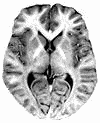 | Multiple Sclerosis |
 | Multiple Sclerosis |

What is Multiple Sclerosis (MS)?MS is a neurological disease that occurs when the insulating material ("myelin") around nerve cells in the central nervous system is damaged. The word sclerosis comes from the Greek word "skleros," meaning hard. In multiple sclerosis, hard areas called "plaques" develop along a neuron's axon. "Multiple" refers to the many different areas of the nervous system that may have damaged myelin. People with MS can experience symptoms such as difficulties in walking, visual problems, and pain.MS is NOT contagious and it is not fatal. However, because MS disrupts the way messages are sent through the nervous system, the symptoms of MS can be serious and disabling. MS is considered to be an autoimmune disease. This means that a person's immune system attacks its own tissue. In MS, the immune system attacks myelin. The Immune SystemYour body is always on the look-out for foreign invaders such as bacteria and viruses. If these invaders get into your body they may make you sick. However, your body has defense mechanisms to fight these microorganisms and prevent infections. These defense mechanisms make up your immune system. Some immune cells can remove the invaders themselves and others cause extra blood to be directed to the site of infection and produce inflammation. Other immune cells produce chemicals or "antibodies" to find and eliminate harmful invaders. The cells that produce antibodies are located in the lymphatic system (see picture on the left), a group of organs including the bone marrow, thymus, spleen, lymph nodes, tonsils and appendix. These cells travel into other parts of the body when they detect an invader or some foreign matter. The organs of the lymphatic system are connected by a series of lymphatic vessels that eventually empty into the bloodstream.Sometimes, the immune system sees parts of its own body as foreign and attacks them in what is called an "autoimmune response." In the case of MS, the immune system attacks the myelin around nerve cells in the brain and spinal cord. |
What Causes MS?Although the exact cause of MS is not known, several environmental and genetic factors probably contribute to the autoimmune response.Environmental Factors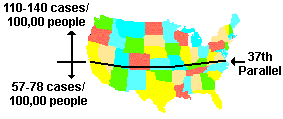 Researchers have discovered that the risk of MS is
greater with increasing distance from the equator. Even in the United
States, MS is more common in northern states than it is in southern
states. The rate of MS in the United States below the 37th parallel is
57 to 78 cases per 100,000 people. Above the 37th parallel, the rate of
MS is 110 to 140 cases per 100,000 people -- approximately twice the
rate as below the 37th parallel. However, the reason for this
distribution of MS is unknown. It is possible that something (e.g., a
virus) in the environment triggers the autoimmune response. Researchers have discovered that the risk of MS is
greater with increasing distance from the equator. Even in the United
States, MS is more common in northern states than it is in southern
states. The rate of MS in the United States below the 37th parallel is
57 to 78 cases per 100,000 people. Above the 37th parallel, the rate of
MS is 110 to 140 cases per 100,000 people -- approximately twice the
rate as below the 37th parallel. However, the reason for this
distribution of MS is unknown. It is possible that something (e.g., a
virus) in the environment triggers the autoimmune response.
Genetic FactorsSusceptibility to MS probably has a genetic component. If a person has MS, there is an increased risk that a close relative, such as a child or sibling will have MS. The identical twin of a person with MS has about a 33% chance of developing MS. However, because this chance is not 100%, MS is not strictly an inherited disorder. |
What Happens to the Nervous System?MS affects neurons in several ways:
When myelin is damaged, the transmission of electrical signals along axons is impaired. It is possible that the body can repair damaged myelin after inflammation is reduced. This process is called "remyelination." |
Normal Neuron
Neuron Affected by MS |
Who Gets MS? What are the Symptoms?People usually develop symptoms of MS when they are 20 to 40 years old; MS is two to three times more common in women than in men. The National Multiple Sclerosis Society estimates that 1,000,000 people in the US have MS. | |
Common
symptoms:
|
Other possible symptoms:
|
|
Symptoms of MS vary from person to person. There are several courses
that the disease may take. Relapsing-Remitting MS: people show symptoms of the disease, but then seem to recover. After a period of time, the symptoms appear again. The cycle of symptoms-to-recovery continues over time. This is the most common type of MS. Primary Progressive MS: people show gradual worsening of symptoms without recovery. Secondary Progressive MS: people first show periods of recovery, but later enter a stage of gradual worsening of symptoms without recovery. | ||
Relapsing-Remitting MS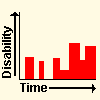 |
Primary Progressive MS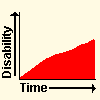 |
Secondary Progressive MS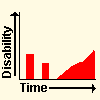 |
How Do You Know if Someone has MS?Patients will usually talk to a doctor about their medical history and the symptoms that they have been experiencing. A doctor may then run a few tests to confirm the diagnosis. Some of the early symptoms of MS may also be signs of other diseases, so it may take time to make a positive diagnosis. Some of the tests doctors use are magnetic resonance imaging, lumbar puncture and evoked potential recording.
Magnetic Resonance Imaging (MRI)The MRI uses strong magnetic fields to create an image of the brain and spinal cord. In 70 to 95% of the people with MS, the MRI will show patches of tissue that are inflamed or destroyed.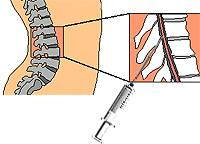
Lumbar PunctureA lumbar puncture is a procedure used to sample cerebrospinal fluid (CSF), the liquid that surrounds the brain and spinal cord. A long needle is inserted between the vertebrae around the spinal cord and a small amount of fluid is withdrawn. Patients with MS often have elevated levels of inflammatory cells in the CSF.Evoked PotentialsMeasuring evoked potentials involves recording the electrical activity of the brain from scalp electrodes. Light flashes (visual evoked potentials), sounds (auditory evoked potentials) or small shocks to the skin (somatosensory evoked potentials) are can be used to synchronize the electrical activity of the brain. Because the myelin surrounding axons is damaged in MS, the electrical impulses within neurons will be smaller or slower than normal.How is MS Treated?CorticosteroidsCorticosteroids are chemicals related to hormones produced by the adrenal gland. These drugs work as anti-inflammatory agents and also suppress the body's immune system. Although corticosteroids can reduce the duration of symptoms, they do not cure MS. Examples of corticosteroids are methylprednisolone, prednisone and adrenocorticotropic hormone.InterferonsInterferon drugs suppress the immune response and also act as anti-viral agents. Beta interferon drugs have shown to be effective in treating the relapsing-remitting type of MS.Glatiramer AcetateGlatiramer acetate is a compound that resembles myelin. When patients take this medication, the immune system appears to attack it rather than natural myelin and allows some patients to go into remission.ImmunosuppressantsImmunosuppressant drugs block or inhibit features of the immune system, thus reducing the chance that the body will continue to attack its own myelin. Examples of immunosuppressant drugs are methotrexate, cyclophosphamide, cyclosporine, and mitoxantrone. | ||
 Hear it! |
Antibodies | Cerebrospinal Fluid |
| Multiple Sclerosis | Myelin |
|
References and further information: Joy, J.E. and Johnston, Jr., R.B. (editors), Multiple Sclerosis. Current Status and Strategies for the Future. Washington, D.C.: National Academy Press, 2001.
Multiple Sclerosis Resources
|
| BACK TO: | Neurological Disorders | Table of Contents |
![[email]](./gif/menue.gif) Send E-mail |
![[newsletter]](./gif/menunew.gif) Get Newsletter |
![[search]](./gif/menusea.gif) Search Pages |